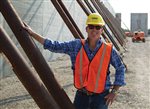Transload facility will benefit ‘everyday consumers’
Construction of rail-based transload facility underway after more than a decade of planning

KATHY A. BOLTEN Aug 3, 2021 | 10:22 pm
7 min read time
1,654 wordsBusiness Record Insider, Real Estate and Development, Transportation
In late May, an explosion occurred at a steel plant in Pueblo, Colo., causing the facility to be shut down.
The effects of the closure of the plant that makes tracks for railways was felt more than 780 miles away in Des Moines. The Evraz Rocky Mountain Steel Plant had had a contract to produce the 15,500 linear feet of rail infrastructure to be installed at a transload facility under construction in Des Moines.
“We had to scramble to find another track supplier, not an easy thing to do,” said Gabe Claypool, president and chief operating officer of Des Moines Industrial LLC, which is developing the $25 million project at 200 E. 15th St.
“It’s not like there’s 20 other railroad track suppliers across the street that you can turn to for track.”
The explosion was just one of many hurdles the transload project has had to clear since planning for it began more than a decade ago. The Des Moines Area Metropolitan Planning Organization, which spearheaded the facility’s planning, ended an agreement in 2018 with a Nebraska company that had been selected to operate the transload facility after it was learned the company’s owners faced federal indictments. The following year, two other companies withdrew from consideration as potential operators for the facility.
When Claypool and business partner Paul Cownie, Des Moines Industrial’s CEO, (pictured) became involved with the project, they thought some of the preliminary work had been completed. But when they reviewed plans for a facility and new rail tracks, they determined the proposed site layout was not feasible and started over from scratch.
The partners maneuvered through a maze of federal, state and city requirements before getting the necessary approvals to develop the 40-acre site. The pandemic caused further delays in getting the approvals.
Construction on a 115,000-square-foot warehouse began in the spring and is expected to be completed by January. Installation of rail infrastructure is also underway.
“Developers before us failed,” Cownie said. “So the fact that we have gotten [the warehouse] under construction and we’re going to be operational by Jan. 1, I think is a really big deal.”
Project unaffected by rising material costs
The Greater Des Moines area is one of a few metros in the United States to be served by three national rail carriers and one regional carrier, according to the Des Moines Metropolitan Planning Organization. Yet the Des Moines area, where Interstate Highways 80 and 35 intersect, lacks a transloading facility found in other metros with heavy rail activity.
The MPO proposed development of a site where goods were transferred from one mode of transportation – rail or semi-trailer truck – to another. The first study was completed in 2006; another in 2013. The MPO vision for the transload site included a large warehouse at which to store the goods waiting to be transported and what’s called a laydown yard, an outside storage area.
The project had several starts and stops before development began in March.
Nearly all of the precast concrete panels that form the exterior of the warehouse facility are erected. Next steps include installing joists, putting on the roof, pouring concrete in the interior of the building, and completing interior finishes including electrical and plumbing.
Cownie credits both luck and good planning for the minimal effect that rising costs and availability of materials have had on the transloading facility’s construction. Nationwide, developers, general contractors and others have reported costs for products made of steel, lumber and concrete surging 20% or more and difficulty in obtaining some types of material.
Bids for the transload project were locked in last fall, a move that helped avoid construction delays, Cownie said. “We had all of our concrete, all of our electrical, all of our steel … done before the world got lit on fire from a construction and materials standpoint.”
After the Pueblo steel plant fire, which injured eight people, general contractor Ryan Cos. was able to help find another supplier, Claypool said.
“Ryan Cos. has been pretty creative in keeping us on track and moving forward, even after curveballs like that that you can’t foresee or can really do nothing about,” he said.
Explaining a transload facility’s benefits
Cownie and Claypool are seeking a tenant for the warehouse, which will include 12 loading dock doors on the south truck loading side and seven loading dock doors on the north side primarily for rail transloading. The facility also will include two drive-thru truck bays.
“We’re looking for a tenant who will use our rail infrastructure and help drive the transloaded traffic,” said Cownie, who with Claypool will have offices in a 2,800-square-foot area on the west side of the facility.
The partners are also busy meeting with business owners and managers, explaining how the facility could benefit their transportation needs.
“It’s not like you just take your supply chain that’s been working for the last five, 10, 100 years and turn it on a dime,” Claypool said. “It’s going to take a little while for people to fully appreciate what this solution now enables them to do both with inbound and outbound freight.”
Transporting commodities by rail is not faster than moving it with trucks, Claypool said. However, trucking can be more expensive and, because the industry is experiencing a shortage of drivers, is not as reliable as it was a decade or so ago.
Still, he said, transporting commodities by truck is reasonable if the product is being moved 200 to 300 miles. Use of rail makes sense when moving a product 300 or more miles, Claypool said.
“You can put the equivalent of about four truckloads of a product into one rail car,” he said. “So what we can do with rail is not only move a lot more freight, but also reduce greenhouse gas emissions by about 75%.”
An example is the movement of lumber from the West Coast to Iowa, Claypool said. If an Iowa lumberyard receives 400 truckloads of lumber a year, that means 400 semis with 400 different drivers must travel to and from the West Coast to Iowa. A train, with two engineers and 100 cars, can deliver the lumber in one trip, he said.
“It’s expensive to truck products that last 250 miles or so,” Cownie said. “Hopefully we’re going to have some cost savings for people who are delivering products to this community.”
Future plans for the transload facility
Cownie and Claypool are hopeful that within two years, at least 1,000 rail cars a year are moving through the site. Eventually, they’d like to see the number grow to 5,000 rail cars a year, Claypool said.
“That might be a stretch but it could happen if the railroads decide to service our facility – i.e., pick up [rail] cars or drop off cars more frequently,” he said.
The warehouse is designed to double in size, or up to 230,000 square feet, Cownie said. Space exists on the property for an additional 75,000 square feet of warehousing space, he said. “That’s going to be a demand decision.”
The size of the laydown yard, which is planned to the east of the warehouse, will be dependent on the number of rail cars traveling to and from the site, Claypool said.
The transload facility can help boost economic development in Iowa, Claypool said.
“It’s things like bringing in equipment and materials to help with the growth in Iowa,” he said. “We’ve all seen the reports about the number of housing units that are being built [in Iowa]. That means more roads and sewers and other services.
“All of that product has to come from other places, whether it’s lumber or steel or rock to make the concrete. We’re looking to bring clients in that ultimately benefit the everyday consumer.”
Economic assessment required before federal grant distributed
Before a 40-acre tract southeast of downtown Des Moines could be transformed into a place to transfer commodities from one mode of transportation to another, an environmental assessment of the ground had to be conducted.
The assessment filled 1,100 pages and took nearly 18 months to complete, said Gabe Claypool, president and chief operating officer of Des Moines Industrial, which is developing the project at 200 E. 15th St.
In late 2018, the project was awarded an $11.2 million federal Department of Transportation BUILD grant. However, the environmental assessment was required before the federal money could be distributed, Claypool said. “A lot of different groups had to sign off on the [land] being a safe piece of property to put federal dollars towards.”
Among the entities whose approval was needed were the U.S. Environmental Protection Agency, U.S. Fish and Wildlife Service, Army Corps of Engineers, Iowa State Historical Preservation Office, city of Des Moines, Iowa Department of Natural Resources and seven federally recognized Indian tribes, according to a report issued by the Federal Railroad Administration.
As information was being gathered for the assessment, the coronavirus began spreading through the country. Government offices were closed, making it difficult to obtain copies of documents needed to complete the assessment, Claypool said.
Meetings were also difficult to arrange, he said. “We had to get all three tiers of government – local, state and federal – together for meetings that were held virtually. It wasn’t easy.”
Moving forward, albeit, slowly, was the only option, Claypool said. The federal grant “was the economic catalyst that this project needed to move forward.”
– Kathy A. Bolten
250 truckloads of junk
The property that Des Moines Industrial LLC purchased for the rail-based transload site was once a salvage yard, said Paul Cownie, Des Moines Industrial’s CEO. “We’ve taken 250 truckloads of garbage off the site,” he said. Items that were uncovered include tree stumps, tires, school bus seats and a locomotive engine, he said. Many of the items had been buried 75 or more years, he estimated. “The site’s gotten cleaned up, that’s for sure.”











